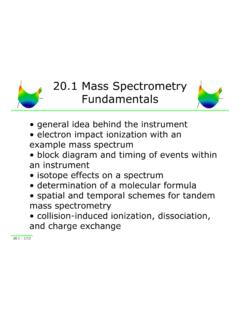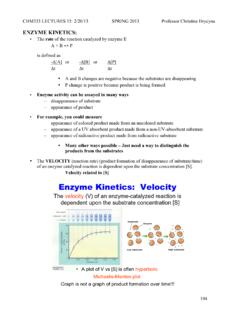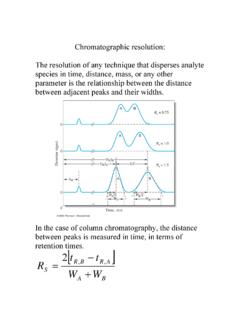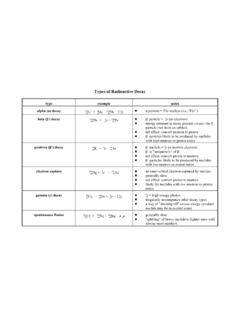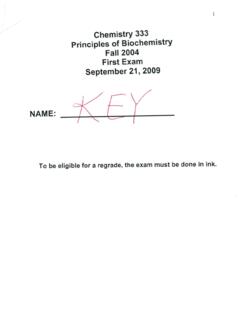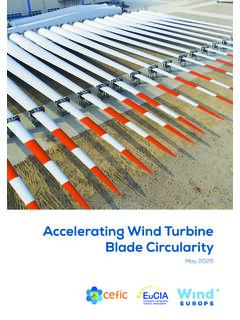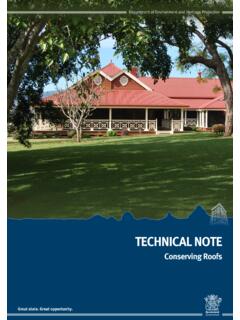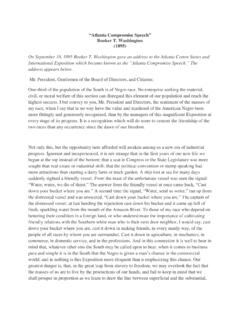Transcription of THEORY OF XRF - Purdue University
1 The Analytical X-ray CompanyISBN: 90-9016758-7 THEORY OF XRFG etting acquainted with the principlesPeter BrouwerGetting acquainted with the principlesPeter BrouwerTHEORY OF XRFF irst published in The Netherlands under the title THEORY of XRF . Copyright 2003 by PANalytical BV, The rights reserved. No part of this publication may be reproduced, stored in a retrieval system or transmitted in any form by any means electronic, mechanical, photocopying or otherwise without first obtaining written permission of the copyright edition published in 2010 by: PANalytical Lelyweg 1, 7602 EA Almelo Box 13, 7600 AA Almelo The Netherlands Tel: +31 (0)546 534 444 Fax: +31 (0)546 534 598 90-9016758-7 3rd editionGetting acquainted with the principlesTHEORY OF XRFP eter BrouwerPANalytical THEORY of XRF42010, PANalytical , Almelo, The NetherlandsPeter N.
2 Brouwer, born April 2, 1958 in Almelo, the Netherlands. He studied Applied Mathematics at the University of Technology in Enschede from where he graduated in 1985. In December 1985 he joined Philips Analytical, currently PANalytical, where he mainly worked on the development of analytical software modules in close cooperation with the Philips Research Laboratories in of his activities has been giving presentations and participating in XRF courses. That has resulted in this book being written. The objective was to make an easy to understand general introduction to XRF, without using difficult details and mathematics, that could be read and understood by people new in PANalytical5 Contents1.
3 Introduction ..72. What is XRF ..83. Basics of XRF .. What are X-rays .. Interaction of X-rays with matter .. production of characteristic fluorescent radiation .. Absorption and enhancement effects .. Absorption and analysis depths .. Rayleigh and Compton scatter .. Geometry of XRF spectrometers .. Polarization ..184. The XRF spectrometer .. Small spot instruments .. EDXRF spectrometers with 2D optics .. EDXRF spectrometers with 3D optics .. WDXRF spectrometers .. Comparison of EDXRF and WDXRF spectrometers .. X-ray tubes .. Secondary targets .. Fluorescent targets .. Barkla targets.
4 Bragg targets .. Detectors and multi channel analyzers .. Multi channel analyzer (MCA) .. ED solid-state detector .. Gas-filled detector .. Scintillation detector .. Escape peaks and pile-up peaks .. Comparison of different detectors .. Filters .. Diffraction crystals and collimators .. Lens .. Masks .. Spinner .. Vacuum and helium system ..385. XRF analysis .. Sample preparation .. Solids .. Powders .. Beads ..40 PANalytical THEORY of Liquids .. Material on filters .. XRF measurements .. Optimum measurement conditions .. Qualitative analysis in EDXRF .. Peak search and peak match.
5 Deconvolution and background fitting .. Qualitative analysis in WDXRF .. Peak search and peak match .. Measuring peak height and background subtraction .. Line overlap correction .. Counting statistics and detection limits .. Quantitative analysis in EDXRF and WDXRF .. Matrix effects and matrix correction models .. Line overlap correction .. Drift correction .. Thin and layered samples .. Analysis methods .. Balance compounds .. Normalization .. Standardless analysis ..566. Recommended literature ..577. Index ..58 Introduction PANalytical71.
6 IntroductionThis booklet gives a general introduction to X-Ray fluorescence (XRF) spectrometry and XRF analysis. It explains simply how a spectrometer works and how XRF analysis is done. It is intended for people new to the field of XRF analysis. Difficult mathematical equations are avoided and the booklet requires only a basic knowledge of mathematics and booklet is not dedicated to one specific type of spectrometer or one application area, but aims to give a broad overview of the main spectrometer types and 2 briefly explains XRF and its benefits. Chapter 3 explains the physics of XRF, and Chapter 4 describes how this physics is applied to spectrometers and their components.
7 Chapter 5 explains how an XRF analysis is done. It describes the process of sample taking, measuring the sample and calculating the composition from the measurement , Chapter 6 gives a list of recommended literature for further information on XRF What is XRFXRF is an analytical method to determine the chemical composition of all kinds of materials. The materials can be in solid, liquid, powder, filtered or other form. XRF can also sometimes be used to determine the thickness and composition of layers and method is fast, accurate and non-destructive, and usually requires only a minimum of sample preparation.
8 Applications are very broad and include the metal, cement , oil, polymer, plastic and food industries, along with mining, mineralogy and geology, and environmental analysis of water a nd waste materials. XRF is also a very useful analysis technique for research and system s can be divided into two main groups: energy dispersive systems (EDXRF) and wavelength dispersive systems (WDXRF), explained in more detail later. The elements that can be analyzed and their detection levels mainly depend on the spectrometer system used. The elemental range for EDXRF goes from sodium to uranium (Na to U). For WDXRF it is even wider, from beryllium to uranium (Be to U).
9 The concentration range goes from (sub) ppm levels to 100%. Generally speaking, the elements with high atomic numbers have better detection limits than the lighter precision and reproducibility of XRF analysis is very high. Very accurate results are possible when good standard specimens are available, but also in applications where no specific standards can be measurement time depends on the number of elements to be determined and the required accuracy, and varies between seconds and 30 minutes. The analysis time after the measurement is only a few 1 shows a typical spectrum of a soil sample measured with EDXRF - the peaks are clearly visible.
10 The positions of the peaks determine the elements present in the sample, while the heights of the peaks determine the PANalytical9 Figure 1. Typical spectrum of a soil sample measured with an EDXRF spectrometerPANalytical THEORY of XRF103. Basics of XRFIn XRF, X-rays produced by a source irradiate the sample. In most cases, the source is an X-ray tube but alternatively it could be a synchrotron or a radioactive material. The elements present in the sample will emit fluorescent X-ray radiation with discrete energies (equivalent to colors in optical light) that are characteristic for these elements.
